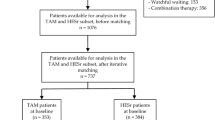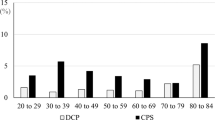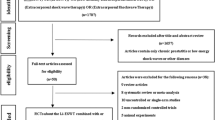Abstract
Background:
The potential benefits of a therapeutic regimen for chronic pelvic pain syndrome (CPPS) based on the adherence to some specific rules concerning diet, sexual habits and lifestyle have never been investigated.
Methods:
A review of literature was executed to prepare a vademecum of 13 rules relating to diet, sexual habits and lifestyle that patients had to adhere to in order to treat CPPS. Patients affected by CPPS were enrolled and assigned to two equal groups that were both treated with 100 mg of nimesulide for 1 week. Group two patients were instructed to adhere to the vademecum rules, whereas patients in Group one received instructions to make no changes in their lifestyles. The NIH-Chronic Prostatitis Symptom Index was administered at baseline and after 3 months. The main outcome measure was the change in the mean total NIH-Chronic Prostatitis Symptom Index scores between the two groups from baseline to after treatment. Statistical methods for two-group comparisons were used.
Results:
Overall,100 patients were recruited. Thirty-nine out of fifty patients (78%) belonging to Group two adhered to the vademecum rules. In Group one, the total NIH-Chronic Prostatitis Symptom Index score was 21.9 at baseline and 17.6 post-treatment, whereas in Group two these scores were 22.1 and 8.1, respectively (P<0.0001).
Conclusions:
We detected 13 potentially eliminable risk factors for CPPS on the basis of which we prepared a vademecum of 13 rules to treat this disease that were well tolerated and highly effective in significantly reducing all types of symptoms caused by CPPS.
This is a preview of subscription content, access via your institution
Access options
Subscribe to this journal
Receive 4 print issues and online access
$259.00 per year
only $64.75 per issue
Buy this article
- Purchase on Springer Link
- Instant access to full article PDF
Prices may be subject to local taxes which are calculated during checkout



Similar content being viewed by others
References
Krieger JN, Lee SW, Jeon J, Cheah PY, Liong ML, Riley DE . Epidemiology of prostatitis. Int J Antimicrob Agents 2008; 31 (Suppl 1): S85–S90.
Krieger JN, Nyberg L Jr, Nickel JC . NIH consensus definition and classification of prostatitis. JAMA 1999; 282: 236–237.
Weidner W, Schiefer HG, Krauss H . Role of Chlamydia trachomatis and mycoplasmas in chronic prostatitis: a review. Urol Int 1988; 43: 167–173.
Nickel JC, Costerton JW . Coagulase-negative staphylococcus in chronic prostatitis. J Urol 1992; 147: 398–400.
Krieger JN, Riley DE, Vesella RL, Miner DC, Ross SO, Lange PH . Bacterial DNA sequences in prostate tissue from patients with prostate cancer and chronic prostatitis. J Urol 2000; 164: 1221–1228.
Tanner MA, Shoskes D, Shahed A, Pace NR . Prevalence of corynebacterial 16S rRNA sequences in patients with bacterial and ‘nonbacterial’ prostatitis. J Clin Microbiol 1999; 37: 1863–1870.
de la Rosette JJ, Hubregtse MR, Meuleman EJ, Stolk-Engelaar MV, Debruyne FM . Diagnosis and treatment of 409 patients with prostatitis syndromes. Urology 1993; 41: 301–307.
Schaeffer AJ, Landis JR, Knauss JS, Propert KJ, Alexander RB, Litwin MS et al. Chronic Prostatitis Collaborative Research Network Group. Demographic and clinical characteristics of men with chronic prostatitis: the National Institutes of Health chronic prostatitis cohort study. J Urol 2002; 168: 593.
Nickel JC, Krieger JN, McNaughton-Collins M, Anderson RU, Pontari M, Shoskes DA et al. Chronic Prostatitis Collaborative Research Network. Alfuzosin and symptoms of chronic prostatitis-chronic pelvic pain syndrome. N Engl J Med 2008; 359: 2663–2673.
Aubin S, Berger RE, Heiman JR, Ciol MA . The association between sexual function, pain, and psychological adaptation of men diagnosed with chronic pelvic pain syndrome type III. J Sex Med 2008; 5: 657–667.
Liang CZ, Li HJ, Wang ZP, Xing JP, Hu WL, Zhang TF et al. The prevalence of prostatitis-like symptoms in China. J Urol 2009; 182: 558–563.
Fall M, Baranowski AP, Elneil S, Engeler D, Hughes J, Messelink EJ et al. European Association of Urology. EAU guidelines on chronic pelvic pain. Eur Urol 2010; 57: 35–48.
Moldwin RM . Similarities between interstitial cystitis and male chronic pelvic pain syndrome. Curr Urol Rep 2002; 3: 313–318.
Parsons CL . The role of the urinary epithelium in the pathogenesis of interstitial cystitis/prostatitis/urethritis. Urology 2007; 69 (Suppl): 9–16.
Forrest JB, Nickel JC, Moldwin RM . Chronic prostatitis/chronic pelvic pain syndrome and male interstitial cystitis: enigmas and opportunities. Urology 2007; 69 (Suppl): 60–63.
Pontari MA . Chronic prostatitis/chronic pelvic pain syndrome and interstitial cystitis: are they related? Curr Urol Rep 2006; 7: 329–334.
Nickel JC, Teichman JM, Gregoire M, Clark J, Downey J . Prevalence, diagnosis, characterization, and treatment ofprostatitis, interstitial cystitis, and epididymitis in outpatient urological practice: the Canadian PIE Study. Urology 2005; 66: 935–940.
Forrest JB, Schmidt S . Interstitial cystitis, chronic nonbacterial prostatitis and chronic pelvic pain syndrome in men: a common and frequently identical clinical entity. J Urol 2004; 172: 2561–2562.
Oxford Centre for Evidence-based Medicine Levels of Evidence (May 2001). Produced by Bob Phillips, Chris Ball, Dave Sackett, Doug Badenoch, Sharon Straus, Brian Haynes, Martin Dawes since November 1998. http://www.cebm.net/index.aspx?o=1025. (accessed March 2014).
Giubilei G, Mondaini N, Crisci A, Raugei A, Lombardi G, Travaglini F et al. The Italian version of the National Institutes of Health Chronic Prostatitis Symptom Index. Eur Urol. 2005; 47: 805–811.
Meares EM Jr, Stamey TA . Bacteriologic localization patterns in bacterial prostatitis and urethritis. Invest Urol 1968; 5: 492–518.
Anderson RU, Sawyer T, Wise D, Morey A, Nathanson BH . Painful myofascial trigger points and pain sites in men with chronic prostatitis/chronic pelvic pain syndrome. J Urol 2009; 182: 2753–2758.
Bartoletti R, Cai T, Mondaini N, Dinelli N, Pinzi N, Pavone C et al. Italian Prostatitis Study Group. Prevalence, incidence estimation, risk factors and characterization of chronic prostatitis/chronic pelvic pain syndrome in urological hospital outpatients in Italy: results of a multicenter case-control observational study. J Urol 2007; 178: 2411–2415.
Collins MM, Meigs JB, Barry MJ, Walker CE, Giovannucci E, Kawachi I . Prevalence and correlates of prostatitis in the health professionals follow-up study cohort. J Urol 2002; 167: 1363–1366.
Yavascaoglu I, Oktay B, Simsek U, Ozyurt M . Role of ejaculation in the treatment of chronic non-bacterial prostatitis. Int J Urol 1999; 6: 130–134.
Drabick JJ, Gambel JM, Mackey JF . Prostatodynia in United Nations peacekeeping forces in Haiti. Mil Med 1997; 162: 380–383.
Giubilei G, Mondaini N, Minervini A, Saieva C, Lapini A, Serni S et al. Physical activity of men with chronic prostatitis/chronic pelvic pain syndrome not satisfied with conventional treatments—could it represent a valid option? The physical activity and male pelvic pain trial: a double-blind, randomized study. J Urol 2007; 177: 159–165.
Hu JC, Link CL, McNaughton-Collins M, Barry MJ, McKinlay JB . The association of abuse and symptoms suggestive of chronic prostatitis/chronic pelvic pain syndrome: results from the Boston Area Community Health survey. J Gen Intern Med 2007; 22: 1532–1537.
Itza F, Zarza D, Serra L, Gómez-Sancha F, Salinas J, Allona-Almagro A . Myofascial pain syndrome in the pelvic floor: a common urological condition. Actas Urol Esp 2010; 34: 318–326.
Leibovitch I, Mor Y . The vicious cycling: bicycling related urogenital disorders. Eur Urol 2005; 47: 277–286.
Nickel JC . Prostatitis: lessons from the 20th century. BJU Int 2000; 85: 179.
Osborn DE, George NJ, Rao PN, Barnard RJ, Reading C, Marklow C et al. Prostatodynia–physiological characteristics and rational management with muscle relaxants. Br J Urol 1981; 53: 621–623.
Sacco E, Totaro A, Marangi F, Pinto F, Racioppi M, Gulino G et al. Prostatitis syndromes and sporting activities. Urologia 2010; 77: 126–138.
Shoskes D Commentary on Chronic Prostatitis/Chronic Pelvic Pain Syndrome, Vol. 3. The Status Quo Is Not Good Enough (But It Can Be), 2010. www.urotodayinternationaljournal.com.
Shoskes DA, Berger R, Elmi A, Landis JR, Propert KJ, Zeitlin S, Chronic Prostatitis Collaborative Research Network Study Group. Muscle tenderness in men with chronic prostatitis/chronic pelvic pain syndrome: the chronic prostatitis cohort study. J Urol 2008; 179: 556–560.
Wallner LP, Clemens JQ, Sarma AV . Prevalence of and risk factors for prostatitis in African American men: the Flint Men's Health Study. Prostate 2009; 69: 24–32.
Bade JJ, Peeters JM, Mensink HJ . Is the diet of patients with interstitial cystitis related to their disease? Eur Urol 1997; 32: 179–183.
Koziol JA, Clark DC, Gittes RF, Tan EM . The natural history of interstitial cystitis: a survey of 374 patients. J Urol 1993; 149: 465–469.
Link CL, Pulliam SJ, Hanno PM, Hall SA, Eggers PW, Kusek JW et al. Prevalence and psychosocial correlates of symptoms suggestive of painful bladder syndrome: results from the Boston area community health survey. J Urol 2008; 180: 599–606.
Shorter B, Lesser M, Moldwin RM, Kushner L . Effect of comestibles on symptoms of interstitial cystitis. J Urol 2007; 178: 145–152.
Azadzoi KM, Babayan RK, Kozlowski R, Siroky MB . Chronic ischemia increases prostatic smooth muscle contraction in the rabbit. J Urol 2003; 170: 659–663.
Kozlowski R, Kershen RT, Siroky MB, Krane RJ, Azadzoi KM . Chronic ischemia alters prostate structure and reactivity in rabbits. J Urol 2001; 165: 1019–1026.
Nickel JC, Moon T, Pavone Macaluso Re. Chronic bacterial prostatitis: an evolving clinical enigma. Urology 2005; 66: 2–8.
Nickel JC, Downey J, Clark J, Casey RW, Pommerville PJ, Barkin J et al. Levofloxacin treatment for chronic prostatitis/chronic pelvic pain syndrome (CP/CPPS) in men: a randomized placebo controlled multi-center trial. J Urol 2003; 62: 614–617.
Kramer MK, McWilliams JR, Chen HY, Siminerio LM . A community-based diabetes prevention program: evaluation of the group lifestyle balance program delivered by diabetes educators. Diabetes Educ 2011; 37: 659–668.
Rigsby BD . Hypertension improvement through healthy lifestyle modifications. ABNF J 2011; 22: 41–43.
Pontari M . Inflammation and anti-inflammatory therapy in chronic prostatitis. Urology 2002; 60: 29–34.
Canale D, Scaricabarozzi I, Giorgi P, Turchi P, Ducci M, Menchini-Fabris GF . Use of a novel non-steroidal anti-inflammatory drug, nimesulide, in the treatment of abacterial prostatovesiculitis. Andrologia 1993; 25: 163–166.
Author information
Authors and Affiliations
Corresponding author
Ethics declarations
Competing interests
The authors declare no conflict of interest.
Appendices
Appendix 1
Appendix 1 Diet, sexual habits and lifestyle rules
Diet:
-
Avoid consumption of all kinds of alcohol beverages
-
Avoid consumption of spicy foods, pepper, chilli and coffee
-
Follow a correct diet assuming each day 50% carbohidrates, 30% fats and 20% proteins
-
Increase your intake of fruits, vegetables and foods rich of natural fibers (dark bred, vegetables, spinaches)
Sexual activity
-
Avoid having two ejaculations during the same day
-
Avoid period of sexual abstinence longer than 4 days
-
Do not try to delay ejaculation in both intercourse and masturbation
-
Do not practice interrupted coitus as contraceptive method (ejaculate outside of partner’s vagina)
Lifestyle and perineal traumatism
-
Walk and practice relaxing sport activities (swimming, jogging, free exercises).
-
Avoid sedentary activities and sitting position for long time. Use a donut-shaped cushion if seated for longtime
-
Avoid sports that can be traumatic for your prostate (bicycling, motorcycling, horse riding etc.)
-
Avoid to wear tight underpants or trousers
-
Take frequent hot baths or bidets during which relax and release pelvic muscles
Appendix 2
Appendix 2 Questionnaire to detect risk factors
Dear patient, in order to investigate the potential causes of your problem is very important that you refill this questionnaire in the most sincere and honest way:
Diet
During the previous three months:
Did you drink alcohol beverages (wine, beer, spirits)? YES □ NO □
Did you drink more than one cup of coffee each day? YES □ NO □
Did you consume pepper, hot chilli and/or spicy foods? YES □ NO □
Did you have an excessive diet: high intake of carbohydrates (bread, pizza, rice and pasta) and/or high intake of fats (fried food, cakes, cured meats, cheese, milk) YES □ NO □
Did you have symptoms of bowel dysfunction (meteorism, irregular rectal function, abdominal constipation and/or frequent episodes of diarrhea, abdominal swelling after dinner, slow digestion)? YES □ NO □
Sexual habits
During the previous three months:
Did you try to delay ejaculation during intercourse and/or at masturbation? YES □ NO □
Did you have periods of sexual abstinence (absence of ejaculations) longer than four days? YES □ NO □
Did you have two ejaculations on the same day? YES □ NO □
Did you use coitus interruptus as anticoncepcional method (coming out of your partner’s vagina)? YES □ NO □
Lifestyle
During the previous three months:
Did you have a sedentary life? YES □ NO □
Perineal traumatism
During the previous three months:
Did you have frequently a sitting position (for example driving car or sitting in front of a computer for long time)? YES □ NO □
Did you practice sports or activities that created pelvic traumatic stimulations (bycycling, motorcycling, horse-riding)? YES □ NO □
Did you wear constrictive clothing (underpants, trousers etc)? YES □ NO □
Rights and permissions
About this article
Cite this article
Gallo, L. Effectiveness of diet, sexual habits and lifestyle modifications on treatment of chronic pelvic pain syndrome. Prostate Cancer Prostatic Dis 17, 238–245 (2014). https://doi.org/10.1038/pcan.2014.18
Received:
Revised:
Accepted:
Published:
Issue Date:
DOI: https://doi.org/10.1038/pcan.2014.18
This article is cited by
-
Experiences of pain debut and healthcare received in men with chronic pelvic pain syndrome
BMC Urology (2023)
-
Diagnostic and Management Strategies for Patients with Chronic Prostatitis and Chronic Pelvic Pain Syndrome
Drugs & Aging (2021)
-
The risk factors related to the severity of pain in patients with Chronic Prostatitis/Chronic Pelvic Pain Syndrome
BMC Urology (2020)
-
Management of Chronic Prostatitis (CP)
Current Urology Reports (2018)
-
Association of diet and lifestyle with chronic prostatitis/chronic pelvic pain syndrome and pain severity: a case–control study
Prostate Cancer and Prostatic Diseases (2016)



